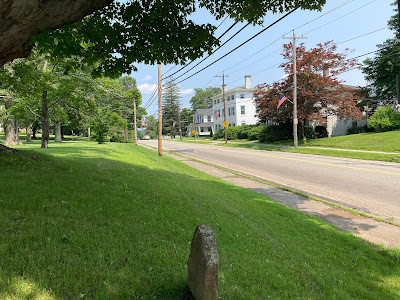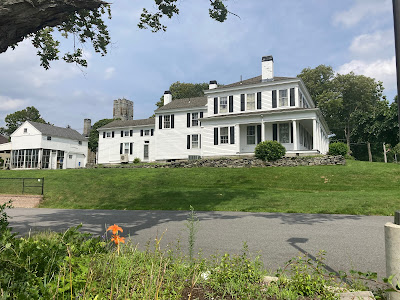Leicester, Massachusetts - "Great Care Is To Be Taken"
The lead element of the re-united Convention Army marched through Leicester, Massachusetts, on November 2, 1777. Massachusetts Militia Lieutenant Israel Bartlett, a guard with the British column, noted in his journal for that day: "... marched thro' Leicester and halted at Worcester, 14 miles from our last quarters." [1] More British prisoners passed through on November 3rd. The journal of an officer of the 47th Regiment of Foot notes they made a seventeen mile march from Brookfield to Worcester that day which would have taken them through Leicester, but makes no mention of that. [2]
The Germans, who marched behind the British and stayed in town the night of November 3rd, were more descriptive: "Our march went via Spencer to Leicester today [November 3] and came 14 Engl. miles. The houses were close to each other and in part very beautiful; most of them were two stories high!" [3] As had been the case since Palmer, the road they took was marked by milestones. Four of these can be found in town today, including a replica now located on the Town Common.Their march through Leicester offers insight into the logistical planning that went into moving over five thousand prisoners, dependents and guards from Saratoga to Cambridge. Article V of the Articles of Convention provided that "The troops are to be supplied on their march ... with provisions, by General Gates's orders, at the same rate of rations as the troops of his own army; and if possible the officers' horses and cattle are to be supplied with forage at the usual rates." In order to accomplish this, Brigadier-General John Glover had divided the prisoners into two columns which would march along separate routes through New York, over the Berkshires, and across the Connecticut River before coming together on a common route across Worcester and Middlesex counties.
Like most all towns in Massachusetts, Leicester had established a network of committees to support the Revolution, headed by prominent citizens loyal to the Patriot cause. In October of 1777, Colonel William Henshaw, who had served under Major-General Horatio Gates during the siege of Boston, was notified by letter from Springfield that the Convention Army would be passing through his town. Henshaw was directed to provide quarters, wood and forage for livestock to the column. "Great care is to be taken that the strictest attention be paid to the Convention signed by General Gates, therefore it behooves you to make the best provision possible... Humanity, I make no doubt will influence you so far as to stimulate you in the utmost Exertions for their Accommodations. The bearer of this will advise with you, & you will please give to him all the assistance in your power." [4]
It's questionable as to how well Colonel Henshaw was able to carry out his orders. The Germans found the people of Leicester to be no more welcoming than those of Brookfield. There, on November 2nd, residents had refused to accept the prisoners into their homes, stating that neither the Continental Congress, General Gates or Colonel Reid, who commanded the militia escorting the German column, could ask them to do that. In Leicester German troops found it to be the same. "The 3rd, we marched through Spencer to Luster or Leicester. The people - as to feelings - were like those of Brookfield." [5] Brunswicker Grenadier Johann Bense's entry for both days, and the day before when the German column was in Palmer, recorded the results: "November 1, 2, 3 in the woods." [6]
The Convention Army entered Leicester from the west, on what was then the Post Road, taking what is known locally as "Breezy Bend", and continued on by way of present-day Route 9. At the center of town, where what is now "Old Main Street" splits off to the left from Route 9, they passed the Swan Tavern and Leicester Town Common. The Swan Tavern, seen here from the west, is now owned by the town and operated by its Historical Commission in conjunction with the Leicester Historical Society. The tavern section, the oldest part of the building, is the center of the three sections which make up the current structure.




Comments
Post a Comment